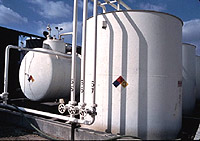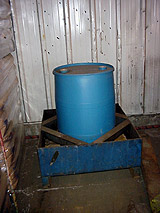Shipyard Employment eTool
General Requirements >> Pressure Vessels, Drums and Containers
Worker injuries can be caused by the rupture of vessels under pressure. Precautions must be taken to prevent over-pressurization and the vessels must meet the American Society of Mechanical Engineers (ASME) guidelines of design and construction. [29 CFR 1915.172]
Note: Confined space entry is one of the leading hazards associated with barge cleaning. Review Ship Repair: Confined or Enclosed Spaces and Other Dangerous Atmospheres for information on how to protect workers from this hazard.

Potential Hazards
Worker injuries from flying debris or fluids may be caused from rupturing pressure vessels such as:
- Abrasive blasting hoppers
- Air compressor holding tanks
- Air receivers
- Air surge tanks
- Paint pots
- Pressurized water tanks

Requirements and Example Solution
- Portable, unfired pressure vessels must be designed and constructed to meet ASME Boiler and Pressure Vessel Code. Hydrostatic testing must be conducted and a record maintained. [29 CFR 1915.172(a), (b), and (d)] Relief valves must be set to the safe working pressure. [29 CFR 1915.172(c)]

Potential Hazard
Worker injuries from flying debris, fluids, and fire and explosions may be caused from rupturing drums or containers.

Requirements and Example Solutions
- Shipping drums and containers must not be pressurized to remove their contents. [29 CFR 1915.173(a)]
- Temporary pressurized piping systems conveying hazardous liquids or gases must be provided with a relief valve and bypass to prevent rupture. [29 CFR 1915.173(b)]
- Pressure vessels, drums, and containers containing toxic or flammable liquids or gases must not be stored or used near ignition or heat sources. [29 CFR 1915.173(c)]
- Pressure vessels, drums, and containers containing flammable or toxic liquids or gases must be stored in safe areas to prevent physical damage. [29 CFR 1915.173(d)]
- Containers of 55 gallons or more containing flammable or toxic liquid must be protected by dikes or pans. [29 CFR 1915.173(e)]
- Fire extinguishers adequate in number and suitable for the hazard must be provided. [29 CFR 1915.173(f)]


